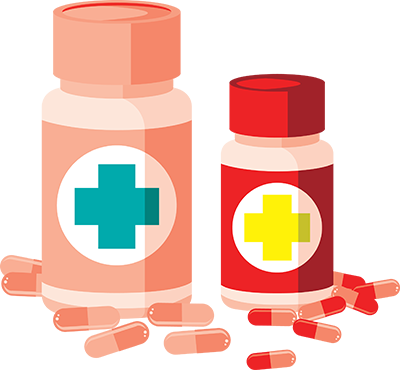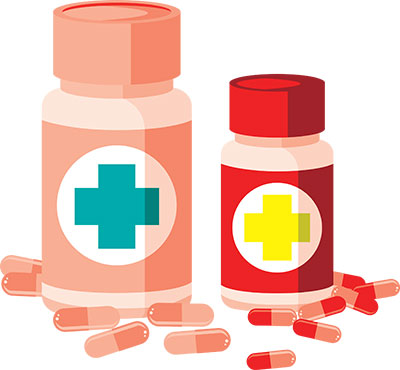
Drug Detox Template

Processed from the coca plant, native to South America, cocaine is an addictive stimulant that creates feelings of euphoria, excitement, and talkativeness. The drug is most often used in powder form, which is either inhaled through the nose or diluted in water and injected. Cocaine also appears in rock crystal form, called crack, which can be heated to produce vapors that are then inhaled into the lungs.
In 2008, the National Survey on Drug Use and Health estimated about 1.9 million cocaine users, about 359,000 of which were crack cocaine users. In that same year, the NSDUH found that nearly 1.4 million Americans met the criteria of dependence on or abuse of cocaine. Roughly one in four drug abuse or misuse visits to the emergency room involved cocaine. The 2013 survey found that cocaine use went down, though it still remains high at about 1.5 million Americans age 12 and older.
Symptoms of Cocaine Addiction
Drugs use chemicals that disrupt the brain’s entire communication system, rerouting the way your brain sends, receives, and processes information. Drugs can create this disruption by either over-stimulating the brain’s reward center or imitating neurotransmitters that naturally occur in your body.
Cocaine causes your nerve cells to release dopamine in unnaturally large volumes while also preventing its natural recycling. Dopamine is a neurotransmitter that controls motivation, movement, emotion, and pleasure, over-stimulating the brain’s reward systems. This essentially teaches people to repeat the action of taking cocaine in order to maintain those pleasurable, euphoric feelings.
- Weight loss, malnourishment, and decreased appetite
- Unpredictable changes in mood
- Unseasonable clothing to cover arms, legs, and other parts of the body where cocaine has been injected
- Alienation of close friends and family
- Continuing to use cocaine even though it is causing legal, financial, and relationship problems
Effects of Drug Detox
Processed from the coca plant, native to South America, cocaine is an addictive stimulant that creates feelings of euphoria, excitement, and talkativeness. The drug is most often used in powder form, which is either inhaled through the nose or diluted in water and injected. Cocaine also appears in rock crystal form, called crack, which can be heated to produce vapors that are then inhaled into the lungs.
In 2008, the National Survey on Drug Use and Health estimated about 1.9 million cocaine users, about 359,000 of which were crack cocaine users. In that same year, the NSDUH found that nearly 1.4 million Americans met the criteria of dependence on or abuse of cocaine. Roughly one in four drug abuse or misuse visits to the emergency room involved cocaine. The 2013 survey found that cocaine use went down, though it still remains high at about 1.5 million Americans age 12 and older.

Dangers of Drug Abuse
- Cardiovascular disease (arrhythmia, heart attack, increased blood pressure)
- Lung damage
- Ulcers and perforation of the stomach and intestines
- Stroke
- Severe paranoia
- Anxiety
- Depression
Complications of Drug Use
- Kidney failure caused by rhabdomyolysis
- Contracting HIV, hepatitis C, and other blood-borne diseases from shared needles
- Nosebleeds, loss of sense of smell, and even nasal perforation
- Severe bowel gangrene (when cocaine is ingested by mouth)
- Overdose
- Erratic, reckless behavior

Medical Intervention
Medical Intervention for Cocaine Addiction
Recovering from any sort of addiction often requires some help from medication, which can reduce withdrawal symptoms and help the general detoxification process. Some common medications used to help cocaine addiction treatment include:
- Antabuse – A drug mainly used to treat alcoholism, Antabuse has also been shown to effectively reduce cocaine abuse when used in conjunction with cognitive behavioral therapy.
- Neurontin – Designed as an anticonvulsant that makes cocaine cravings more manageable and reduces the severity of relapse.
- Sabril – An anti-epileptic drug, Sabril can reduce cocaine cravings by increasing the brain’s GABA neurotransmitter.
- N-acetylcysteine – This medication is an amino acid that can curb cravings and repair damage to the brain caused by cocaine use.
RECOVERY
Recovering from Cocaine Abuse
Detox is a necessary step to sobriety. It is required to enter more extensive 30-, 60-, or 90-day rehab programs for long-term care. Think of detox as working the chemicals out of your system and repairing your body. Rehab gives you the strength to continue a healthy, happy life.
Georgia Drug Detox offers a wide range of inpatient detox facilities that specialize in helping patients detox from cocaine. We can help you find a treatment center that matches your needs for maximum success. Have any questions or need assistance with insurance? Please don’t hesitate to contact us. If you’re ready to take the first step, call (678) 771-6411 to admit yourself to a cocaine detox treatment center and begin your life anew.

How to Find Facilities in Cocaine Detox
Georgia Drug Detox is dedicated to helping you find and select a detox program that fits your personal needs and gets you on track for recovery. It is important to complete your detox surrounded by supportive professionals who specialize in treating your specific addition, not just addiction in general. Contact us today at (678) 771-6411 and we will walk you through the process today.

